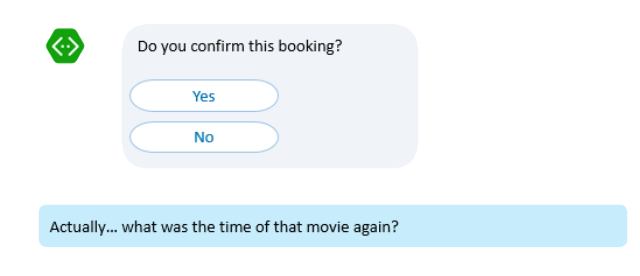Design and control conversation flow
APPLIES TO: SDK v3
In a traditional application, the user interface (UI) is a series of screens. A single app or website can use one or more screens as needed to exchange information with the user. Most applications start with a main screen where users initially land and provide navigation that leads to other screens for various functions like starting a new order, browsing products, or looking for help.
Like apps and websites, bots have a UI, but it is made up of dialogs, rather than screens. Dialogs help preserve your place within a conversation, prompt users when needed, and execute input validation. They are useful for managing multi-turn conversations and simple "forms-based" collections of information to accomplish activities such as booking a flight.
Dialogs enable the bot developer to logically separate various areas of bot functionality and guide conversational flow. For example, you may design one dialog to contain the logic that helps the user browse for products and a separate dialog to contain the logic that helps the user create a new order.
Dialogs may or may not have graphical interfaces. They may contain buttons, text, and other elements, or be entirely speech-based. Dialogs also contain actions to perform tasks such as invoking other dialogs or processing user input.
Using dialogs to manage conversation flow
This diagram shows the screen flow of a traditional application compared to the dialog flow of a bot.

In a traditional application, everything begins with the main screen. The main screen invokes the new order screen. The new order screen remains in control until it either closes or invokes other screens. If the new order screen closes, the user is returned to the main screen.
In a bot, everything begins with the root dialog. The root dialog invokes the new order dialog. At that point, the new order dialog takes control of the conversation and remains in control until it either closes or invokes other dialogs. If the new order dialog closes, control of the conversation is returned back to the root dialog.
For a detailed walkthrough of managing conversation flow using dialogs and the Bot Framework SDK, see:
Dialog stack
When one dialog invokes another, the Bot Builder adds the new dialog to the top of the dialog stack. The dialog that is on top of the stack is in control of the conversation. Every new message sent by the user will be subject to processing by that dialog until it either closes or redirects to another dialog. When a dialog closes, it's removed from the stack, and the previous dialog in the stack assumes control of the conversation.
Important
Understanding the concept of how the dialog stack is constructed and deconstructed by the Bot Builder as dialogs invoke one another, close, and so on is critical to being able to effectively design the conversation flow of a bot.
Dialogs, stacks and humans
It may be tempting to assume that users will navigate across dialogs, creating a dialog stack, and at some point will navigate back in the direction they came from, unstacking the dialogs one by one in a neat and orderly way. For example, the user will start at root dialog, invoke the new order dialog from there, and then invoke the product search dialog. Then the user will select a product and confirm, exiting the product search dialog, complete the order, exiting the new order dialog, and arrive back at the root dialog.
Although it would be great if users always traveled such a linear, logical path, it seldom occurs. Humans do not communicate in "stacks." They tend to frequently change their minds. Consider the following example:

While your bot may have logically constructed a stack of dialogs, the user may decide to do something entirely different or ask a question that may be unrelated to the current topic. In the example, the user asks a question rather than providing the yes/no response that the dialog expects. How should your dialog respond?
- Insist that the user answer the question first.
- Disregard everything that the user had done previously, reset the whole dialog stack, and start from the beginning by attempting to answer the user's question.
- Attempt to answer the user's question and then return to that yes/no question and try to resume from there.
There is no one right answer to this question, as the best solution will depend upon the specifics of your scenario and how the user would reasonably expect the bot to respond. However, as your conversation complexity increases dialogs become harder to manage. For complex branchings situations, it may be easier to create your own flow of control logic to keep track of your user's conversation.
Next steps
Managing the user's navigation across dialogs and designing conversation flow in a manner that enables users to achieve their goals (even in a non-linear fashion) is a fundamental challenge of bot design. The next article reviews some common pitfalls of poorly designed navigation and discusses strategies for avoiding those traps.